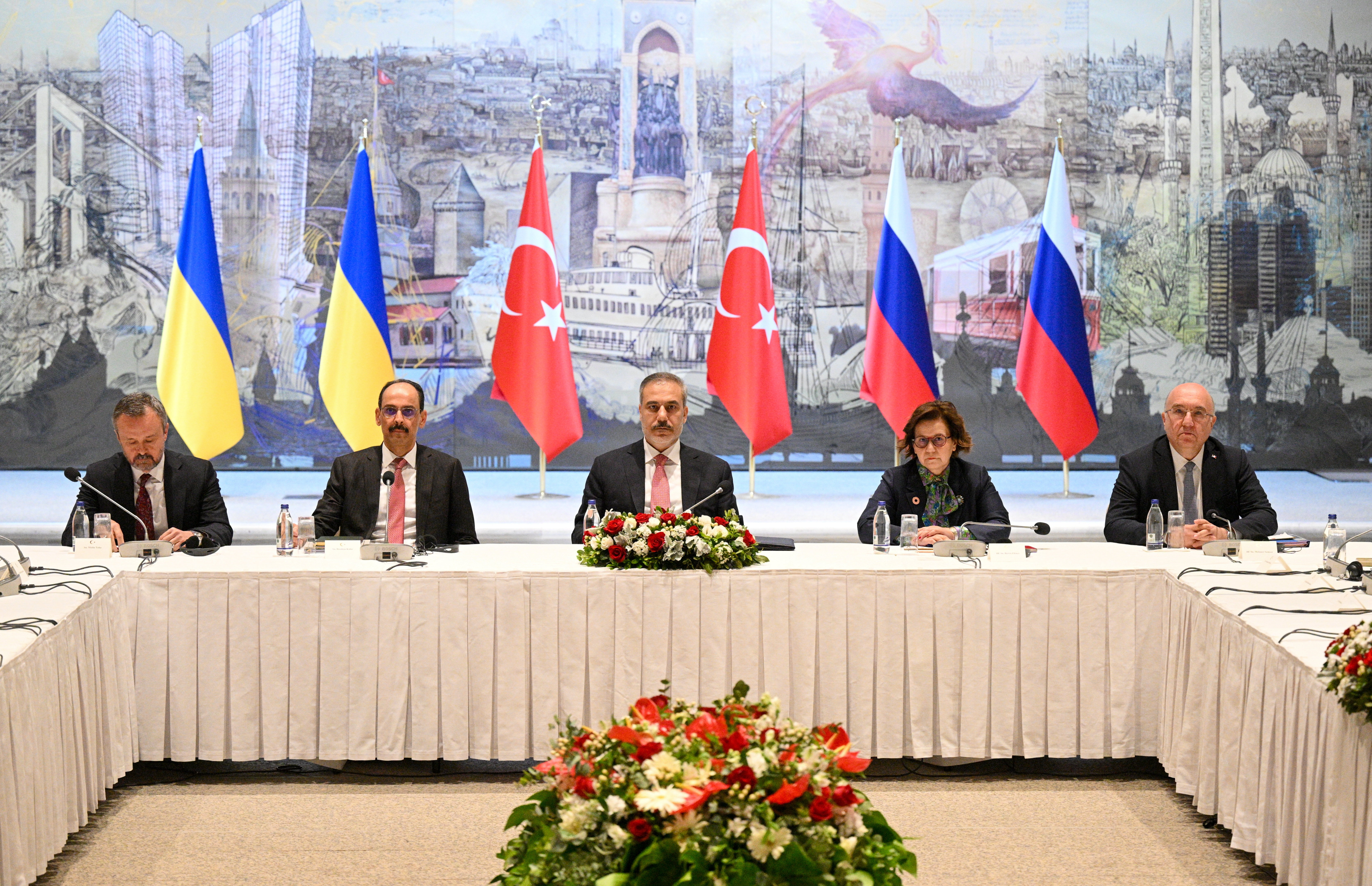Russian-Ukrainian Delegations Meet in Istanbul
The first official, direct Ukrainian-Russian talks since 2022 took place on 16 May in Istanbul, but did not bring any breakthrough. Only further negotiations will show whether Russia will consider abandoning at least some of its demands. However, the outcome of a telephone conversation between U.S. President Donald Trump and Russian leader Vladimir Putin on 19 May points to a scenario in which pressure will be exerted on Ukraine to abandon some of its demands. This increases the importance of maintaining broad Western support for Ukraine and increasing pressure on the Russian authorities to end military operations as soon as possible.
 Ramil Sitdikov / Zuma Press / Forum
Ramil Sitdikov / Zuma Press / Forum
The Meeting in Istanbul
The Ukrainian-Russian talks, originally scheduled for 15 May, took place a day later in the presence of Turkish Foreign Minister Hakan Fidan and lasted almost two hours. During the talks, Russia and Ukraine agreed only to exchange prisoners of war according to the “1,000 for 1,000” formula. Russia rejected Ukraine’s proposal for a ceasefire, which had been worked out after consultations with President Trump during a meeting of the leaders of the so-called European Four (E4; France, Germany, Poland, and the United Kingdom) in Kyiv on 10 May. In addition, Russia presented its own demands, which Ukraine considered unrealistic. The Ukrainian side also insisted on direct talks between their leaders, Volodymyr Zelensky and Putin, which effectively would mean that the Russian authorities would have to recognise Zelensky’s legitimacy.
As in 2022, the Russian delegation was led by presidential advisor Vladimir Medinsky (who was a conservative culture minister from 2012 to 2020 and now heads the nationalist Russian Military-Historical Society, which promotes the Russian perspective on history) and included Mikhail Galuzin, deputy foreign minister, Igor Kostyukov, head of the Main Intelligence Directorate and deputy chief of the General Staff, and Alexander Fomin, deputy defence minister. The Ukrainian side was led by Defence Minister Rustem Umerov, who was the only participant in the 2022 negotiations. In addition, the talks were attended by Serhiy Kyslytsya, deputy foreign minister, Oleksandr Poklad, deputy head of the Security Service of Ukraine, and Vadym Skibitsky, deputy head of military intelligence, thus matching the Russian side in terms of the level of representation.
The Diplomatic Situation Surrounding the Ceasefire
The talks in Istanbul were preceded by a series of consultations between Ukraine and the U.S., and between Russia and the U.S. (shuttle diplomacy). As a result, the U.S., Ukraine, and the E4 countries prepared a draft agreement on a ceasefire. However, on the same day (10 May), the draft was outright rejected by Putin, who announced his position during a night-time press conference. As a consequence and in order to speed up the negotiations, Trump proposed a meeting in Istanbul, and his initiative was supported by European leaders, including French President Macron.
In response to expectations, Zelensky stated that he was ready to meet with Putin. However, Russia sent a delegation to Türkiye consisting mainly of people who had participated in talks with Ukraine in 2022, demonstrating that it regarded the talks as merely a return to the negotiations of three years ago, which had been intended to end with Ukraine’s capitulation.
Immediately before the start of the Ukrainian-Russian negotiations, representatives of Ukraine, the U.S. and Turkey met in Istanbul (Foreign Ministers Andriy Sybiha and Fidan, U.S. Secretary of State Marco Rubio, as well as Andriy Yermak, the head of President Zelensky’s office, and Keith Kellogg, the U.S. special envoy for Ukraine and Russia. They discussed the state of Ukrainian-Russian negotiations and humanitarian issues, including the release of prisoners of war and the return of Ukrainian children removed to Russia. The U.S. and Ukrainian delegations also met with representatives of Germany, France, and the United Kingdom, with whom a position was agreed upon prior to the meeting with the Russian delegation. On the day of the talks, Russia and Ukraine exchanged the bodies of fallen soldiers—the Russian side handed over 909, and the Ukrainian side 34.
The Framework of Ukraine’s Approach to the Ceasefire Remains Unchanged
Ukraine states that the peace process should now be dependent on the introduction of an unconditional ceasefire for at least 30 days, as well as the return of removed Ukrainian children and civilians detained in Russia and the exchange of prisoners of war on an “all for all” basis. Ukraine also aims to verify the Russian side’s genuine readiness for real negotiations. At the same time, in order to achieve success in further talks, Ukraine must maintain the interest of the U.S., as it can put pressure on Russia to continue the talks. Therefore, in order to show the importance of returning to the negotiations, Zelensky flew to Türkiye, where he had met with Turkish President Recep Tayyip Erdoğan the day before and declared his readiness to go to Istanbul if Putin decided to do so. Meanwhile, Foreign Minister Sybiha was present in Istanbul (although he did not participate in the meeting with the Russians).
Russia’s Demands on Ukraine and the West
Even before the start of negotiations with Ukraine, Russia emphasised that its position has not changed since 2022. Thus, the Russian side reiterated its demands to receive guarantees from Western states that Ukraine would not join NATO and to recognise Crimea and the four Ukrainian regions of Donetsk, Kherson, Luhansk, and Zaporizhzhia (parts of which it still has failed to fully occupy) as part of the Russian state. During the negotiations on 16 May in Istanbul, the Russians firmly stressed that if a ceasefire were to happen before the peace talks were finished, Ukraine would have to give up mobilisation at that time and Western states would have to give up military support, which is not acceptable to the Ukrainian side. It will also be problematic to establish mechanisms to control compliance with the ceasefire, as Russia rejects the possibility of European peacekeepers being deployed in Ukraine, stressing that the countries involved are NATO members. This means that the Russian government is hoping that the protracted war and a possible reduction in the involvement of the U.S. and European countries in supporting Ukraine will intensify pressure on the Ukrainian authorities to accept the unfavourable conditions imposed on them.
Ceasefire Prospects
Russia and Ukraine are due to meet in the near future to discuss possible ceasefire options, but it is not yet certain in what form and where, although Türkiye and the Holy See have said they are ready to organise further rounds of negotiations, and Trump, after a two-hour phone conversation he had with Putin on 19 May, stated that talks would begin “immediately”. Nonetheless, a compromise on the issue will be difficult to work out, as for Russia, a truce will only be part of a broader agreement with Ukraine, rather than a precondition for it.
Further negotiations will therefore be protracted and arduous due to Russia’s lack of real readiness to make any concessions and its firm repetition of its demands, the implementation of which would mean Ukraine’s de facto capitulation. Moreover, Russia’s representatives will seek to prolong the talks, which, with the ongoing hostilities, will mean weakening Ukraine and giving the Russians the opportunity to seize more Ukrainian territory. They will also be counting on the Ukrainian side to break off the talks. Russia is also trying to take advantage of Trump’s desire to conclude peace as soon as possible, without taking into account all Ukrainian demands. This was shown in his telephone conversation with Putin, in which—although it did not produce any concrete results—the U.S. president promised that one the war is over Russia will be able to return to regular trade with the U.S.
Trump also suggests that it is mainly the Ukrainian authorities who should be ready to compromise with Russia. This is indicated by, among other things, the course of the joint conversation Trump had with Zelensky, Macron, EU President Ursula von der Leyen, Chancellor Friedrich Merz, and Finnish President Alexandr Stubb after his phone call to Putin, during which he conveyed the need for immediate ceasefire negotiations with Russia and also stated that trade could help Ukraine rebuild the state.
In response to the course of the talks, European states should increase the pressure on Russia, including by signalling their readiness to introduce further sanctions for prolonging the war. They should also support Ukraine militarily, economically, and diplomatically during the negotiations. At the same time, it will remain important to maintain cooperation with the U.S. in this respect, and European states should indicate to the Americans the need to ensure Ukraine’s interests.




.png)
.png)
(1).png)